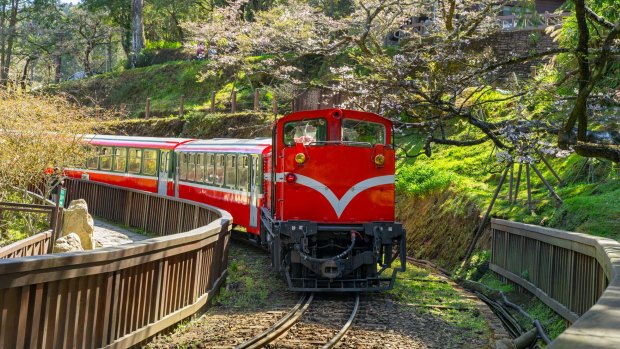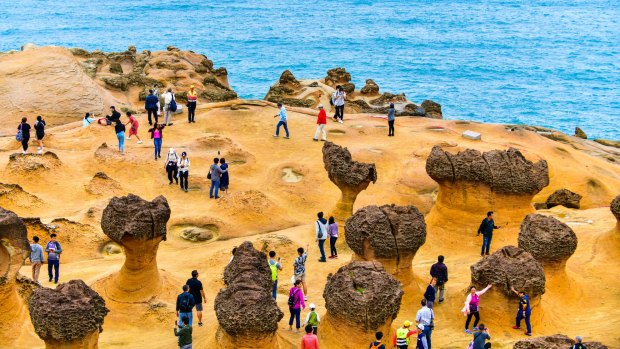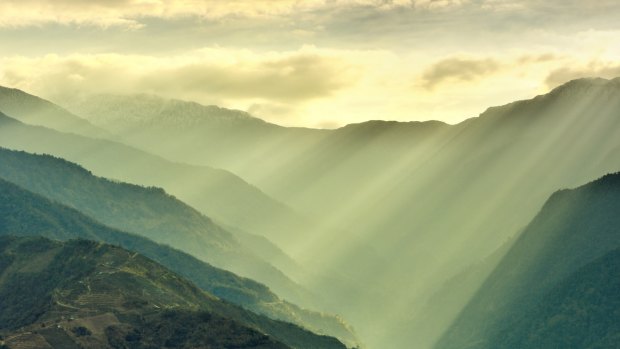This was published 4 years ago
Day trips from Taipei: Taiwan's hottest tourist attraction is also its strangest
By Mark Daffey

Alishan National Scenic Area.Credit: iStock
Thick green foliage frames Taipei's grimy sprawl from my viewpoint on Elephant Mountain. Dominating that view is Taipei 101, formerly the world's tallest building. Beneath it spreads a grid-patterned cityscape that's as grey as the skies above. And beyond is a ring of mountains, only just managing to contain the urban creep.
For the past two days, I've wandered the city streets, trying to see and do as much as I can. From discovering centuries-old temples laced with the sweet scent of burning incense, I ambled through museum halls containing priceless Chinese artefacts. I've also witnessed guard-changing ceremonies in memorial halls dedicated to political figures. By night, I've trolled through bars and jumped on the city's excellent MRT train network to visit bustling night markets, sampling tasty treats with names I never quite grasped.
But the city's siren call is softening. I need a change of scenery, somewhere natural where I can breathe in the fresh country air and smell the cherry blossom that is now flowering. Maybe then I'll begin to understand why Portuguese sailors named Taiwan Ilha Formosa – beautiful island – almost 500 years ago.

Many tourists walk around the stone shapes at Yehliu Geopark.Credit: iStock
Tectonic movements have thrust Taiwan's mountainous spine as high as 3950 metres in the centre of the banana leaf-shaped island, and the volcanic Datun Mountains north of the capital are as volatile as any. More than 20 dormant volcanoes here are protected inside the boundaries of the Yangmingshan National Park, a 100-square-kilometre reserve extending from Taipei's suburban outskirts almost as far as the island's northern tip.
The park's proximity to Taipei makes it a popular weekend getaway. Hikers come to march up summit trails linking Buddhist temples and shrines. Lovers carry picnic dinners to view sunsets over the city. We drive for an hour to Xiaoyoukeng, a volcanic hot spot on the slopes of Mount Qixing. Intense eggy fumes assault our nostrils long before we spy the cause – hissing fumaroles that sound like ocean waves crashing through blowholes. We walk along a scenic trail lined with bamboo to reach them, passing landslides that have left blackened scars on these treeless hills. Despite our lofty elevation, 800 metres above sea level, heat radiates from the steaming vents.
Ponds in other sections of the park provide habitats for rare, endemic ferns, or aquatic frogs and insects. Twitchers come for its rich and varied birdlife. Resort hotels sprung up in the Beitou Thermal Valley during the early half of the 20th century, when Taiwan's Japanese overlords liked to soak in its hot springs.

Tectonic movements have thrust Taiwan's mountainous spine as high as 3950 metres.Credit: Zorazhuang
It's also possible to gaze over the island's battered north-eastern coastline from Yangmingshan's higher peaks and trails. For centuries traders sailed along this coast from China, and shipwrecks litter the waters. These days city folk come here to buy fresh seafood direct from fishing fleets moored at Taiwan's second-largest seaport in Keelung City, and in numerous smaller harbours strung out along the coast.
In places, it's also where hundreds of tourists – domestic and Chinese, largely – have become so focused on capturing photos of themselves sitting and standing on, and lying across, some remarkably weathered rock formations that they ignore warnings prohibiting that exact behaviour. At Yehliu Geopark, a narrow spit of land that bends towards a headland shaped like a turtle, security guards assigned to keep visitors from climbing clustered sandstone formations shaped like fairy shoes and ice-cream cones, shoo people away.
Restraint is at least demonstrated when a line, 100 metres long, forms in front of a naturally sculpted rock that's said to resemble Queen Elizabeth I. The alternative, for those lacking patience, or who couldn't care less about authenticity, is to snap themselves in front of moulded replicas of the queen and other royal doppelgangers, away from the fuss.
Timber causeways funnel day trippers towards the formations, and after dodging tidal potholes and roaming among petrified forests shaped like honeycombed mushrooms, I weave a path through a selfie minefield towards some more distant creations. One mirrors a lion's head, another a peanut. Along the shoreline, tessellated rock shelves mask fossilised cylinders made by sea creatures, who knows how long ago. Even here though, far from the masses, wishing well coins lie in tidal depressions.
Overcrowding similarly mars my experience of visiting the Alishan National Scenic Area, close to the island's centre. The mountainous Alishan reserve is revered among the Taiwanese for its five wonders – to witness the sunrise, gaze over the sea of clouds blanketing the valley floors, ride on its narrow gauge railway, hike its forest trails and watch the sunset's lingering afterglow. I manage to tick off all five, but it's during the sunrise experience when the masses peak. I'm mostly used to seeing sunrises on my own, usually when trying to photograph travel scenes while they're bathed in rich, warm sunlight. Not here though. In Alishan, everyone has the same idea.
All seats are occupied on the pre-dawn train to Zushan Station on Mount Ogasawara, so I find a space in an aisle and stand shoulder to shoulder with countless others for the 30-minute journey. After disgorging at the summit terminal with hundreds of other passengers, we all then scurry uphill to various viewing platforms looking east towards Jade Mountain, waiting for the sun to peek over the brow of Taiwan's highest peak.
It's a different story later that morning, after we've retreated further back down the mountain to the Zhushan Forest. The smell of dampened pine needles perfumes the air and blossoming king cherry trees add colour to the manicured gardens surrounding Alishan House, one of Taiwan's oldest hotels. There's plenty of space for visitors to disperse into the park's 1400 forested hectares from here, and I rejoice in being able to wander alone among towering cypress pines and cedar trees, some estimated to be more than 3000 years old.
It's a similar scenario when we visit the home of an aboriginal Tsou couple residing in the nearby village of Leye, a little further down the mountain. Taiwan's indigenous population numbers just 2 per cent out of 24 million residents. The bulk of them live in mountain areas such as Alishan. Not only are they known around here for farming wasabi and for harvesting sweet oolong tea, but my guide also tells us that they are admired nationwide for their chiselled good looks.
"You see their straight noses and strong foreheads? Not like us Han," she says, giggling.
Like me, it seems that being in the mountains agrees with them.
TRIP NOTES
Mark Daffey visited Taipei courtesy of the Taiwan Tourism Bureau.
MORE
FLY
Taiwan's national carrier, China Airlines, flies direct to the Taiwanese capital, Taipei, from Sydney and Brisbane on a daily basis and three-times weekly from Melbourne.See china-airlines.com.au
STAY
Rooms at the amba Taipei Songshan hotel start from $110 a night on a 21-day advance purchase plan. Standard double rooms at Alishan House cost about $200 a night. See amba-hotels.com/en/songshan/; alishanhouse.hotel.com.tw/eng/
Sign up for the Traveller Deals newsletter
Get exclusive travel deals delivered straight to your inbox. Sign up now.